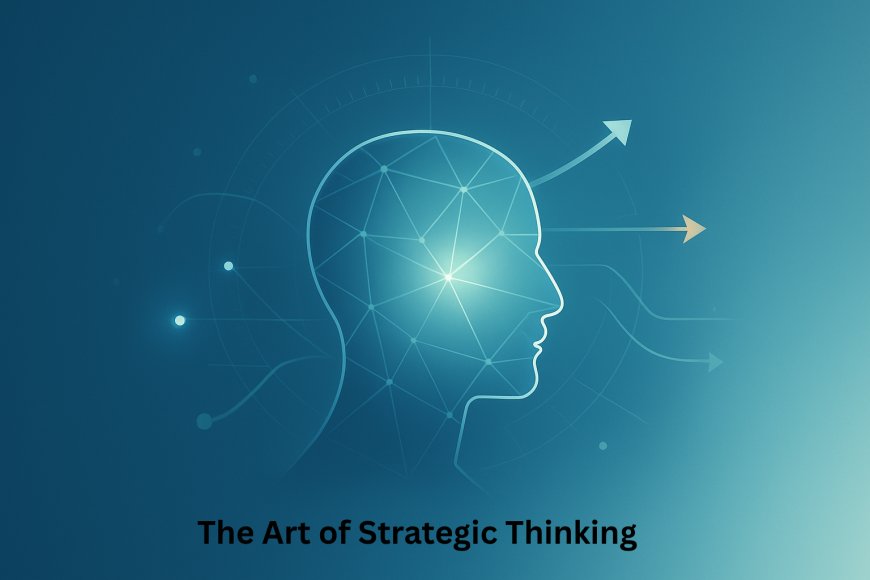The Art of Strategic Thinking
How to see the bigger picture, make smarter decisions, and align your daily work with long-term goals.

You know the feeling — your calendar is packed, your inbox is overflowing, and yet, at the end of the day, you wonder:
“Did I actually move forward today?”
You’re not alone. Most professionals are incredibly good at execution — getting things done, meeting deadlines, solving immediate problems. But being busy isn’t the same as being effective.
That’s where strategic thinking comes in.
Strategic thinking isn’t just for top executives or business consultants. It’s a mindset — a way of viewing your work so you can see beyond the immediate task and understand how your actions connect to the bigger picture.
When you start thinking strategically, you stop reacting to what’s urgent and start focusing on what truly matters. You begin to see patterns, anticipate outcomes, and make decisions that move you — and your organization — forward with purpose.
What Strategic Thinking Really Means
Many people think “strategy” means long meetings, big plans, or thick PowerPoint decks filled with charts. In reality, strategic thinking is about clarity and connection.
It’s the ability to step back and ask:
“Why am I doing this?”
“How does this contribute to the overall goal?”
“What will this decision look like six months from now?”
In simple terms, it’s the shift from doing the work to understanding the work’s impact.
Here’s the difference:
- Tactical thinking asks, “How can I solve this problem today?”
- Strategic thinking asks, “What will this solution mean for the next phase?”
Strategic thinkers look at every task, project, and conversation through a long-term lens. They connect dots that others miss. They see both the forest and the trees.
The Four Pillars of Strategic Thinking
Becoming a strategic thinker isn’t about suddenly “thinking big.” It’s about training your mind to balance detail with direction. Four pillars help you get there:
1. Big-Picture Awareness
Strategic thinkers don’t just focus on their role — they understand how their role fits into the larger mission.
They ask:
- What’s the company’s goal this quarter?
- How does my project contribute to that?
- How do my daily choices impact other teams or customers?
When you connect your work to the broader purpose, you don’t just execute better — you create meaning in what you do.
2. Pattern Recognition
Strategic thinkers are pattern spotters. They observe what’s happening around them — trends in performance, customer behavior, or internal challenges — and use those insights to anticipate what might come next.
It’s less about predicting the future and more about noticing the clues it leaves behind.
3. Prioritization and Focus
You can’t do everything, and strategic thinkers know that. They separate what’s urgent from what’s important and give their time to tasks that create the most value.
When everything feels like a priority, nothing truly is.
4. Long-Term Alignment
Strategic thinking means making choices today that support your future goals. Every decision — from which meeting you attend to which skill you learn — should align with where you want to be six months or three years from now.
It’s not about perfection. It’s about direction.
Developing a Strategic Mindset
Strategic thinking is like a muscle — the more you practice it, the stronger it gets.
Here’s a simple, step-by-step approach to start building your strategic mindset.
Step 1: Ask Bigger Questions
Most people jump straight to how — “How do I fix this?”, “How do I finish it faster?”
Strategic thinkers start with why.
“Why is this problem happening?”
“Why does it matter to the organization?”
“Why now?”
By digging deeper, you uncover the root cause, not just the symptoms.
Step 2: Zoom Out Weekly
Take 30 minutes every Friday to review your week.
Ask yourself:
- What worked well?
- What didn’t move the needle?
- What should I start, stop, or continue next week?
This reflection helps you shift from “getting through the week” to “designing better weeks.”
Step 3: Think in Systems, Not Silos
Your work is part of a larger system — every decision affects others.
Let’s say you change a process to make your job faster. Does it slow someone else down?
Strategic thinkers anticipate these ripple effects. They look for win-win solutions that help the whole system function better.
Step 4: Balance Insight with Action
Some people overthink; others act without thinking. Strategic thinkers do both in balance.
They take the time to analyze — but they also act decisively once they have clarity.
They know that ideas only create impact when they’re executed with intent.
Common Barriers to Strategic Thinking (and How to Overcome Them)
Even the best professionals struggle to think strategically sometimes.
Here are a few common blockers — and how to move past them.
|
Barrier |
What It Looks Like |
How to Overcome It |
|
Constant Busyness |
You’re always in motion but rarely have time to think. |
Schedule “white space” — 30 minutes each week for deep thought or reflection. |
|
Fear of Getting It Wrong |
You delay decisions waiting for perfect data. |
Reframe it: progress > perfection. Test small, learn fast. |
|
Short-Term Pressure |
You focus on deadlines instead of direction. |
Connect each task to the larger goal — ask, “How does this help the mission?” |
|
Lack of Context |
You don’t fully understand the “why” behind what you’re doing. |
Ask leaders or peers for clarity — understanding context builds confidence. |
Strategic thinking thrives in clarity and calm. If your days are packed, start by protecting small thinking spaces — even five minutes of perspective can change how you work.
Strategic Thinking in Action: A Real-World Example
Let’s look at this in practice.
Anita, a marketing manager, was known for her reliability. She executed campaigns flawlessly and hit every deadline — but rarely got noticed beyond her team.
When she started to think strategically, things changed.
Instead of just focusing on campaign performance, she began connecting her team’s work to the company’s long-term positioning. She noticed that while her campaigns drove clicks, they didn’t always align with brand storytelling. So she initiated a strategy review, aligning her team’s messaging with the company’s mission.
The result?
Her campaigns started generating not just traffic, but recognition — from leadership and clients. Anita didn’t work harder; she worked with intention.
That’s the difference strategic thinking makes — it turns contribution into impact.
How Strategic Thinkers Stand Out
Strategic thinkers often share a few traits that set them apart in any organization:
- They ask “why” before “how.”
- They connect everyday tasks to the company’s bigger mission.
- They make decisions based on both logic and foresight.
- They manage time and priorities intentionally.
- They build trust — because their choices show clarity and care.
In short, they don’t just do the job. They shape the direction.
“Strategic thinkers don’t predict the future — they prepare for it.”
Your Strategic Thinking Habit
Here’s a quick reflection exercise:
Think about one decision you made this week — big or small.
Now ask yourself:
“Was that decision reactive or strategic?”
If it was reactive, don’t worry. The goal isn’t to change everything overnight. It’s to build awareness — the moment you start noticing your patterns, you’ve already taken the first step toward thinking more strategically.
You can even keep a “strategy journal” — jot down one situation each week where you zoomed out, spotted a pattern, or connected a short-term action to a long-term goal. Over time, you’ll notice your mindset shifting.
Wrap-Up: Strategy as a Daily Practice
Strategic thinking isn’t a job title. It’s a daily practice — a way of approaching work that helps you move from activity to impact.
It’s about seeing your tasks not as isolated checkboxes, but as building blocks of something bigger.
It’s about stepping back long enough to ask better questions, make wiser choices, and create meaning in what you do.
You don’t need to be a senior leader to think strategically. You just need curiosity, perspective, and the willingness to pause before you act.
Because in the end, success doesn’t come from doing more — it comes from doing what matters most, with purpose and clarity.
When you start thinking strategically, every task becomes a step toward your vision — not just another item on your to-do list.
What's Your Reaction?
 Like
0
Like
0
 Dislike
0
Dislike
0
 Love
0
Love
0
 Funny
0
Funny
0
 Angry
0
Angry
0
 Sad
0
Sad
0
 Wow
0
Wow
0
























































































































































































